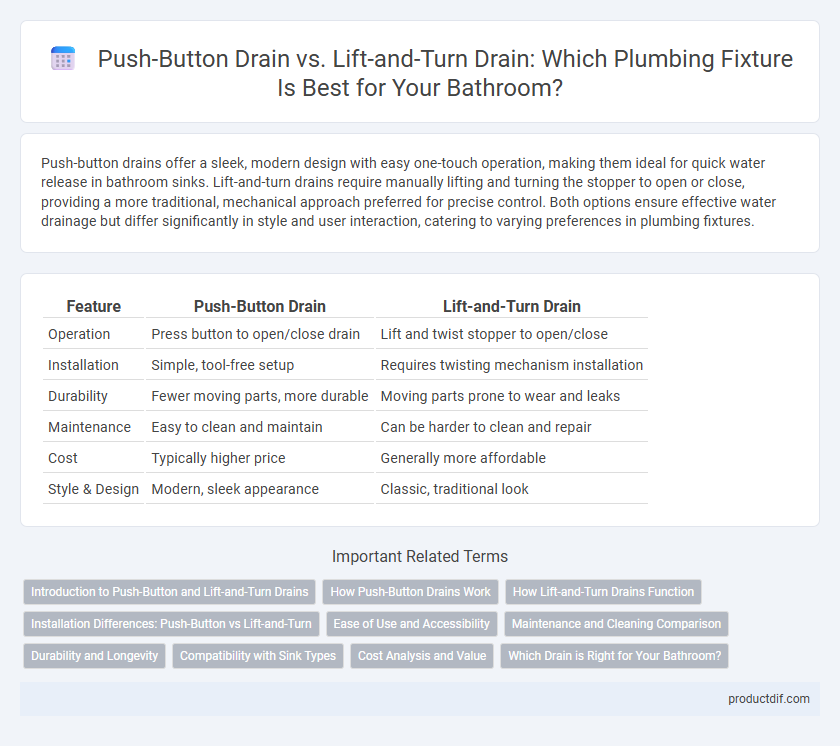Push-button drains offer a sleek, modern design with easy one-touch operation, making them ideal for quick water release in bathroom sinks. Lift-and-turn drains require manually lifting and turning the stopper to open or close, providing a more traditional, mechanical approach preferred for precise control. Both options ensure effective water drainage but differ significantly in style and user interaction, catering to varying preferences in plumbing fixtures.
Table of Comparison
| Feature | Push-Button Drain | Lift-and-Turn Drain |
|---|---|---|
| Operation | Press button to open/close drain | Lift and twist stopper to open/close |
| Installation | Simple, tool-free setup | Requires twisting mechanism installation |
| Durability | Fewer moving parts, more durable | Moving parts prone to wear and leaks |
| Maintenance | Easy to clean and maintain | Can be harder to clean and repair |
| Cost | Typically higher price | Generally more affordable |
| Style & Design | Modern, sleek appearance | Classic, traditional look |
Introduction to Push-Button and Lift-and-Turn Drains
Push-button drains feature a simple press mechanism that allows water to easily flow or stop with a push, providing efficient control and ease of use. Lift-and-turn drains operate by lifting and rotating the stopper, offering a secure seal and traditional functionality preferred in many bathroom sinks. Both types enhance plumbing fixtures by improving water retention and drainage while catering to different user preferences in bathroom design.
How Push-Button Drains Work
Push-button drains operate by pressing the drain cover, which activates an internal spring mechanism to open or close the drain, allowing water to flow out or be retained in the sink. This simple mechanism eliminates the need for a separate stopper lever, providing a streamlined and easy-to-use design. The push-button system is durable and requires minimal maintenance, making it a popular choice for modern bathroom sinks and vessel basins.
How Lift-and-Turn Drains Function
Lift-and-turn drains operate by rotating the drain stopper to open or close the drain, allowing for easy water flow control in sinks and bathtubs. This mechanism uses a threaded shaft connected to the stopper that turns clockwise to seal and counterclockwise to open, providing a secure and leak-resistant closure. The design ensures simple maintenance and durability, making it a popular choice in residential plumbing fixtures.
Installation Differences: Push-Button vs Lift-and-Turn
Push-button drains require a simple snap-in installation without the need for tools, making them quicker and easier to set up compared to lift-and-turn drains, which involve threading and screwing components together. Lift-and-turn drains necessitate aligning the stopper and turning it to lock into place, often requiring a plumber's wrench or adjustable pliers for secure fitting. These installation differences impact maintenance accessibility and the type of sink compatibility, with push-button drains favoring modern sinks and lift-and-turn drains commonly used in older or traditional setups.
Ease of Use and Accessibility
Push-button drains offer superior ease of use with a simple press mechanism that allows for quick opening and closing, making them highly accessible for individuals with limited dexterity. Lift-and-turn drains require twisting a small handle to operate, which can be more challenging for users with arthritis or strength issues. The push-button design minimizes physical effort, enhancing accessibility in both residential and commercial plumbing fixtures.
Maintenance and Cleaning Comparison
Push-button drains offer simpler maintenance with fewer moving parts, reducing the likelihood of clogs and buildup during cleaning. Lift-and-turn drains feature a rotating stopper that can trap debris more easily, requiring regular removal and thorough cleaning to maintain smooth operation. Both types benefit from routine inspection, but push-button drains typically demand less frequent upkeep.
Durability and Longevity
Push-button drains often feature a simple mechanical design with fewer moving parts, resulting in increased durability and reduced chances of wear over time. Lift-and-turn drains contain a rotating stopper mechanism prone to corrosion and mechanical failure, potentially shortening lifespan in high-moisture environments. Choosing a push-button drain generally enhances long-term performance and minimizes maintenance due to its robust and streamlined construction.
Compatibility with Sink Types
Push-button drains are highly compatible with a variety of sink types, especially vessel and undermount sinks, due to their sleek, modern design and ease of installation without requiring a lift rod. Lift-and-turn drains best suit traditional sinks with a built-in overflow, as their mechanism depends on the overflow hole to operate smoothly and prevent water buildup. When choosing between these fixtures, assessing the sink type and overflow presence is crucial for optimal drain function and long-term reliability.
Cost Analysis and Value
Push-button drains generally offer a more cost-effective solution with lower initial purchase prices and simplified installation compared to lift-and-turn drains, making them ideal for budget-conscious projects. Lift-and-turn drains, while typically more expensive upfront, provide durable performance and enhanced control over water flow, delivering long-term value through reduced maintenance and fewer replacements. Evaluating total ownership cost, push-button drains suit short-term affordability, whereas lift-and-turn drains represent a better investment for longevity and reliability in plumbing fixtures.
Which Drain is Right for Your Bathroom?
Push-button drains offer quick, one-touch operation ideal for modern bathrooms requiring convenience and minimal maintenance, while lift-and-turn drains provide a traditional, mechanical design suited for those who prefer tactile control and ease of cleaning. Choosing between push-button and lift-and-turn drains depends on your bathroom style, usability preferences, and ease-of-use requirements. For a sleek, contemporary look with effortless functionality, push-button drains are optimal; for a classic aesthetic with straightforward manual operation, lift-and-turn drains are preferable.
Push-Button Drain vs Lift-and-Turn Drain Infographic

 productdif.com
productdif.com